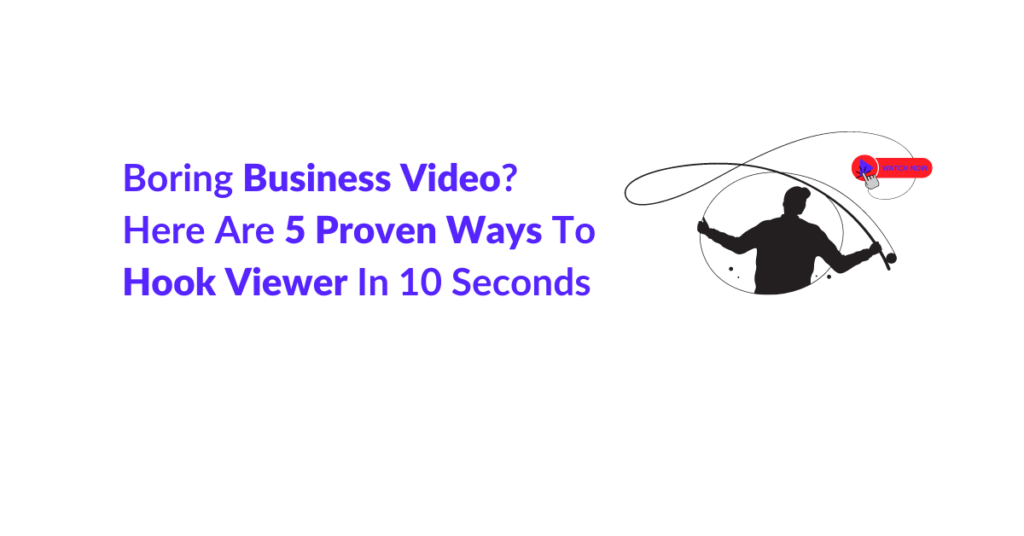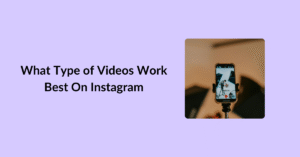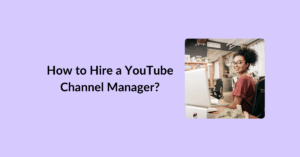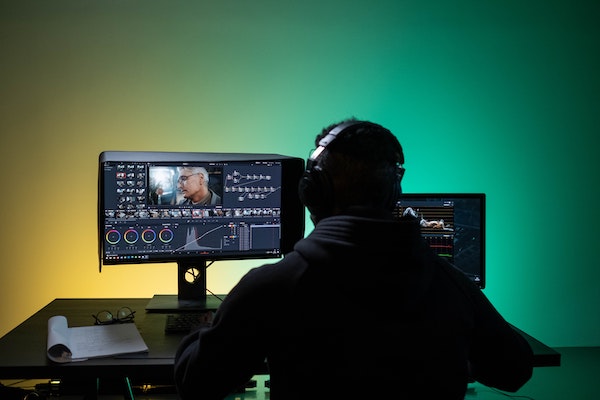78% of marketers say videos have increased their sales. Given this, there is no reason any business should be shying away from video content. It’s definitely a must-have!
However, creating business video content that actually works isn’t that easy. Stats also tell us the average human attention span (as of 2023) is no more than 8.25 seconds. So, if you don’t manage to capture their attention in that time frame — there are slim chances you’ll enjoy a high ROI.
In this post, we’ll share how you can cut down the risks by creating a super strong hook that makes your audience view the whole of your video.
But before we dive into the top 5 battle-tested frameworks for creating a strong hook, let’s see if investing time and effort in this – is the right choice for you at the moment or not…
Table of Contents
Why hook your audience in the first 10 seconds?
Video content is the most expensive form of content. But it is also the most effective.
On average, a 2-minute video can cost you anywhere between $500 – $1500. If you’re hiring a super-skilled and creative video production agency, the costs may exceed $1500. (yep, costs apply to in-house videos, too!)
But these cost estimations are general. The type of video you desire can increase or decrease the actual cost.
However, all types of video content yield a GREAT ROI. Here are some insights to help you get an idea:
- Over half of the most skilled marketers all around the globe say video content has the highest ROI of all content forms.
- 84% of consumers buy a product/service after watching a video.
- Businesses that used video marketing witnessed a 49% increase in revenue.
Given this, you should hook your audience in the first 10 seconds because this is the only guarantee they’ll watch the entire video.
And you can only resonate with the promising stats above if they consume the whole of your video content and take the message you’re trying to deliver.
Summing up, here are some benefits of a strong opening hook:
- Immediate Engagement: Capturing attention early piques curiosity and compels viewers to continue watching, which increases the likelihood of message absorption.
- Enhanced Brand Recognition: A memorable opening reinforces your brand identity, making it more likely for viewers to associate the video’s content with your business.
- Higher Conversions: Engaging hooks can lead to higher viewer retention rates, which again, translates to increased conversions as your message resonates effectively.
Given this, investing time, effort, and money in creating a strong hook is a good deal for you if:
- You’re new to YouTube
- You do not have an established audience
- You’re focused more on immediate sales rather than long-term community building
You might not need to invest extra money and effort if your video targets an audience that’s already familiar with your brand. Why? Because you might have more leeway in developing a hook, as existing engagement levels might be higher.
Similarly, if you’re delivering information-centric content a concise hook might be secondary to the main message. And that’s because your main goal with this piece of content is to deliver in-depth information.
Video content is the most expensive form of content. But it is also the most effective.
On average, a 2-minute video can cost you anywhere between $500 – $1500. If you’re hiring a super-skilled and creative video production agency, the costs may exceed $1500. (yep, costs apply to in-house videos, too!)
But these cost estimations are general. The type of video you desire can increase or decrease the actual cost.
However, all types of video content yield a GREAT ROI. Here are some insights to help you get an idea:
- Over half of the most skilled marketers all around the globe say video content has the highest ROI of all content forms.
- 84% of consumers buy a product/service after watching a video.
- Businesses that used video marketing witnessed a 49% increase in revenue.
Given this, you should hook your audience in the first 10 seconds because this is the only guarantee they’ll watch the entire video.
And you can only resonate with the promising stats above if they consume the whole of your video content and take the message you’re trying to deliver.
Summing up, here are some benefits of a strong opening hook:
- Immediate Engagement: Capturing attention early piques curiosity and compels viewers to continue watching, which increases the likelihood of message absorption.
- Enhanced Brand Recognition: A memorable opening reinforces your brand identity, making it more likely for viewers to associate the video’s content with your business.
- Higher Conversions: Engaging hooks can lead to higher viewer retention rates, which again, translates to increased conversions as your message resonates effectively.
Given this, investing time, effort, and money in creating a strong hook is a good deal for you if:
- You’re new to YouTube
- You do not have an established audience
- You’re focused more on immediate sales rather than long-term community building
You might not need to invest extra money and effort if your video targets an audience that’s already familiar with your brand. Why? Because you might have more leeway in developing a hook, as existing engagement levels might be higher.
Similarly, if you’re delivering information-centric content a concise hook might be secondary to the main message. And that’s because your main goal with this piece of content is to deliver in-depth information.
5 Proven Ways to Hook in Ten Seconds
Now, let’s dive into the five game-changing strategies we promised earlier;
1. Create an Open Loop in the First 1-3 sentences
Imagine starting a story with a secret, a mystery, or a puzzle. That’s what an open loop does – it hooks your audience right from the start. It’s like a mini cliffhanger at the beginning that keeps people curious until they find the answer.
For example, consider this intro of YT video centered around YouTube growth:
In this video, I’m going to share that one teeny tiny YouTube fix that unlocked the gates of massive viewership in just two days….
It’s just the first line. But you’ll continue to watch this video until you find out that ‘teeny tiny fix’.
Psychologically, the open loop exploits the Zeigarnik Effect. It is a psychological phenomenon that states people remember incomplete or unresolved tasks more than completed ones. They’ll keep thinking about that ‘unresolved’ thing until they get some closure.
So, even if someone bounces off your video after listening to the first line, there is a high chance they’ll come back later to get their answer. Or they may save your video to watch later.
As per the Zeigarnik Effect, if video content presents an intriguing scenario or poses a thought-provoking question but delays its resolution, viewers are psychologically driven to stick around and discover the answers.
Here’s another example of open-loop in video content: Consider a cooking video. The host might introduce a mouth-watering dish’s secret ingredient but not reveal it immediately. This entices viewers to watch further to uncover the missing piece of information.
How can you tap into open-loops value? Follow this step-by-step guide:
- Identify the Hook: Pinpoint a captivating element related to your content that you can introduce but not immediately explain or resolve.
- Craft the Opening: Within the first three sentences, introduce the open loop element. Pose a question, highlight a mystery, or present a surprising fact.
- Tease the Resolution: Offer a hint that there’s more to come without giving away the complete answer.
- Deliver Value: After introducing the open loop, ensure the rest of your content is valuable, informative, or entertaining to maintain engagement once the loop is closed.
- Close the Loop: Towards the end of your video, revisit the initial open loop and provide the resolution, answer, or conclusion.
2. Use Number Juxtaposition When Sharing a Stat
Number juxtaposition isn’t really a known method in the realm of video content. But it’s a psychological trick that’s been working for all sorts of marketing techniques. Be it email copy, ad copy, social media posts, and sales pages.
But what is it really?
Well, number juxtaposition is basically a method of quoting numbers such that you pair a commonly read number with an uncommon number in a specific context.
Here are a few examples:
Email Subject Lines
- Increase Your Website Traffic by 300% in Just 7 Days
- From $0 to $10,000: The Power of Our Marketing Strategy
Sales Pages
- Discover How Our Product Helped a Client Go from 10 to 100,000 Subscribers
- Our App Saves You 90% of Your Daily Task Time – Try it Now!
Advertisements
- Lose 20 Pounds in 4 Weeks with Our Revolutionary Fitness Program
- Invest Just $50 for a Chance to Win $5,000
Social Media Posts
- Our Users Saved a Whopping $1 Million with Our Coupon Codes
- Turn Your Hobby into Income: From 100 Likes to $10,000 in Sales
You see, the idea here is to create a contrast between numbers —- with a promise for your reader. If you’re a leadership coach, you can say how a specific client of yours became the go-to person for their team in just X time. And how you can help the viewers achieve the same with the secret you’re sharing in the video….
Getting it?
Here are a few ideas on how you can implement this strong hook-creating strategy in your video content:
1. Video Introductions
Start your video with a short, attention-grabbing statement that includes the number juxtaposition technique. For instance:
- In just 3 days, we transformed a $200 investment into $5,000. Let me show you how.
- From 10 subscribers to a whopping 10,000 – all in a month’s time. Watch and learn.
2. Testimonials and Success Stories
When sharing success stories or testimonials, use this technique to highlight impressive achievements:
- Meet Sarah, who turned her side hustle into $50,000 in profits within a year.
- John’s journey: How he went from 0 to 100 clients in just 2 months.
3. Educational Content
For educational content, you can go about it like this:
- Learn these 3 simple techniques to reduce your expenses by 70% and boost your savings.
- Master this trick to cut your study time in half and still score in the top 5%
4. Before-and-After Scenarios
Illustrate the transformation your content offers by using the technique:
- Watch as we take a messy room and turn it into an organized haven in just 24 hours.
- See how this tired garden flourishes into a vibrant oasis with just a $50 investment.
This contrast can be a part of your video title and the first 1-3 sentences.
3. Start with a Sound Bite
A sound bite is a catchy snippet of information that encapsulates the essence of a larger message. It is usually no more than a sentence or two.
Its purpose is to capture attention, convey a key point, and linger in the minds of the audience. This technique is commonly used in various forms of media and communication and it leverages the psychology of cognition and memory to make information more digestible and impactful.
How so?
Well, our brains are naturally drawn to concise and easily digestible information. When presented with complex concepts or extensive narratives, we often seek anchor points – these are the sound bites that resonate with us. They become mental shortcuts — summing up the main message in only a few words so it’s easy to recall.
The Zeigarnik Effect also plays a role. A well-crafted sound bite creates an initial sense of incompleteness, inciting a desire for closure. Viewers are then driven to continue engaging with your content in pursuit of a more comprehensive understanding.
Here’s an excellent example of this hook strategy in action:
Use a Question to Attack or Empathize
Now, don’t get us wrong here — asking a question in your communication can be like a skillful sword – it can either cut through the noise or touch the heart. Depending on how you use it, a question can be a tool to challenge or connect with your audience, making your message impactful and memorable.
Attacking with a Question
When you want to make your audience think critically or challenge their perspective, an attacking question can be a thought-provoking choice. This technique sparks curiosity by addressing a common assumption, prompting the audience to reevaluate their beliefs. For instance:
- Have you ever wondered why we keep accepting the status quo?
- Is it really wise to follow a system that doesn’t serve us?
Empathizing with a Question
On the flip side, using a question to empathize can foster a deep connection. This technique acknowledges the audience’s feelings or experiences and creates a sense of togetherness. It invites them to reflect on shared challenges and emotions, building trust and engagement:
- Do you ever feel overwhelmed by the demands of modern life?
- Have you experienced those moments when self-doubt creeps in?
Just make sure when incorporating these questions at the beginning of your video, you align with your video’s purpose.
Arrest with Visual and Auditory Edits
This is a hook strategy that you can combine with all of the four above or use independently. The idea here is to edit the video to add super arresting visuals or audio at the beginning. Of course, it should correspond to the overall brand vibe and video message too.
Be it seamless transitions, dynamic cuts, overlay effects, or carefully picked music sync. You can use these elements to intrigue your viewer. Naturally, for this, you’d need the assistance of a skilled and experienced video editor. We recommended browsing our list of 15 best video editing services to outsource to find your perfect video editing partner.
Remember, audio is a key element to hook your audience. Our brains respond differently to different frequencies. Skilled video editors can help you choreograph soundscapes that harmonize with visuals, using music and effects to evoke emotions. Their keen sense of timing infuses suspense, emotion, and impact, guiding the audience’s emotional journey.
End Note
Now that you have all five proven frameworks for creating a strong hook within your hands – go ahead and give them a try! Let us know how it goes for you. We’d be happy to assist you in making your video content more compelling and view-worthy! Check out how we’ve helped our clients grow on YouTube by enriching their videos with some super cool edits: editvideo.io’s work.
Good luck!




